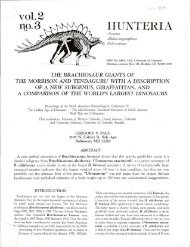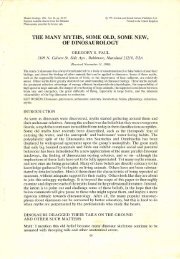Dinosaur models: the good, the bad, and using - Gregory S. Paul
Dinosaur models: the good, the bad, and using - Gregory S. Paul
Dinosaur models: the good, the bad, and using - Gregory S. Paul
You also want an ePaper? Increase the reach of your titles
YUMPU automatically turns print PDFs into web optimized ePapers that Google loves.
CONCLUDING COMMENTS<br />
The results of this study show that volumetric <strong>models</strong> must<br />
be based upon detailed, technically accurate, <strong>and</strong> well documented<br />
skeletal restorations. Off <strong>the</strong> shelf <strong>models</strong>, whe<strong>the</strong>r<br />
found in museums or shops, are prone to substantial error <strong>and</strong><br />
may give misleading results. Despite advertisements to <strong>the</strong> contrary,<br />
many commercial <strong>models</strong> are toy caricatures that inaccurately<br />
represent certain dinosaur taxa, <strong>the</strong>y are not scientifically<br />
reliable <strong>models</strong>. Unless <strong>the</strong>ir accuracy can be established it is<br />
best to avoid <strong>the</strong> use of such <strong>models</strong> in technical studies. Unfortunately<br />
most people who buy dinosaur <strong>models</strong> are not able<br />
to tell what is <strong>and</strong> is not as realistic as current science allow, it<br />
is up to those who produce <strong>and</strong> distribute <strong>the</strong> <strong>models</strong> to ensure<br />
that what is sold meets <strong>the</strong> highest st<strong>and</strong>ards of science.<br />
In <strong>the</strong> future, <strong>the</strong> modeling of dinosaurs promises to go digital.<br />
As <strong>the</strong> ease of <strong>using</strong> computers rises <strong>and</strong> costs decline, extinct<br />
forms will increasingly be restored bone by bone (<strong>and</strong> perhaps<br />
muscle by muscle) in 3-D virtual reality. The volume of <strong>the</strong> final<br />
virtnal model can be measured in <strong>the</strong> computer. The image can<br />
even be translated directly into hard form by various means of<br />
digital-plastic prototyping. Because traditional methods give accurate<br />
results, computer modeling is not expected to result in<br />
dramatic improvements in basic accuracy (indeed, <strong>the</strong> errant results<br />
in Gunga et al. (1995) show that <strong>bad</strong> data scanned into <strong>the</strong><br />
computer results in equally <strong>bad</strong> results out). Where computer<br />
modeling may be most useful is in more precisely restoring <strong>the</strong><br />
internal anatomy <strong>and</strong> weight distribution of <strong>the</strong> extinct subjects.<br />
NOTE AND ACKNOWLEDGMENTS<br />
Readers are reminded that <strong>the</strong> skeletal figures presented here<br />
are under <strong>the</strong> author's copyright, <strong>and</strong> that those who wish to<br />
base commercial images <strong>and</strong> products upon <strong>the</strong>m need to make<br />
<strong>the</strong> proper arrangements. Among <strong>the</strong> many people who have<br />
provided discussion, information <strong>and</strong> o<strong>the</strong>r assistance are F<br />
Boothman, M. Brett-Surman, K. Carpenter, J. Chevalier, J. Farlow,<br />
M. Fortelius, H. Jaeger, D. Kinzig, A. Lister, J. McIntosh,<br />
<strong>and</strong> S. L. Shoshoni.<br />
REFERENCES<br />
ALBL, P 1971. Studies on assessment of physical condition in African<br />
elephants. Biological Conservation, 3:134-140<br />
ALEXANDER,R. M. 1989. Dynamics of <strong>Dinosaur</strong>s <strong>and</strong> o<strong>the</strong>r Extinct<br />
Giants. Columbia University Press, New York.<br />
ANDERSON,J. F, HALL-MARTIN,A., ANDRUSSELL,D. A. 1985. Long<br />
bone circumference <strong>and</strong> weight in mammals, birds <strong>and</strong> dinosaurs.<br />
Journal of Zoology, London A 207:53-61.<br />
AUFFENBERG,W 1981. The Behavioral Ecology of <strong>the</strong> Komodo Monitor.<br />
University of Florida Press, Gainesville.<br />
BELAND, P. AND RUSSELL,D. A. 1978. Palaeoecology of <strong>Dinosaur</strong><br />
Provincial Park, Alberta. Canadian Journal of Earth Sciences, 15:<br />
1012-1024.<br />
BONAPARTE,J. F AND CORIA, R. A. 1993. Un nuevo y gigantesco<br />
sauropodo Titanosauro de la Formacion Rio Limay (Albiano-Cenomaniano)<br />
de la Provincia Del Neuquen, Argentina. Ameghiniana, 30:<br />
271-282.<br />
BRYANT, H. N. AND SEYMOUR,K L. 1990. Observations <strong>and</strong> comments<br />
on <strong>the</strong> reliability of muscle reconstruction in fossil vertebrates.<br />
Journal of Morphology, 206:109-117.<br />
CARPENTER,K 1984. Skeletal reconstruction <strong>and</strong> life restoration of<br />
Sauropelta from <strong>the</strong> Cretaceous of North America. Canadian Journal<br />
of Earth Sciences, 21:1491-1498.<br />
---, 1988. Review. Delaware Valley Paleontological Society<br />
Newsletter, 10(4):1-22.<br />
---, MADSEN,J. H., ANDLEWIS,A. 1994. Mounting of fossil vertebrate<br />
skeletons, 285-322. In P Leggi <strong>and</strong> P. May (eds.), Vertebrate<br />
Paleontological Techniques. Cambridge University Press, Cambridge.<br />
CAMPBELL,K E. ANDMARCUS,L. 1992. The relationship of hindlimb<br />
bone dimensions to body weight in birds, 395-412. In K E. Campbell<br />
Dinofest









